Software Defined Networking: Overview, Applications, Challenges, and Future Research
VerifiedAdded on 2022/10/10
|11
|2171
|314
AI Summary
This report provides an overview of Software Defined Networking (SDN) technology, its applications, challenges, and future research. It discusses the decoupling of hardware and control, centralized network provisioning, holistic enterprise management, higher granular security, and cloud abstraction. It also highlights the vulnerability of the controller, literature gap, and future research directions.
Contribute Materials
Your contribution can guide someone’s learning journey. Share your
documents today.
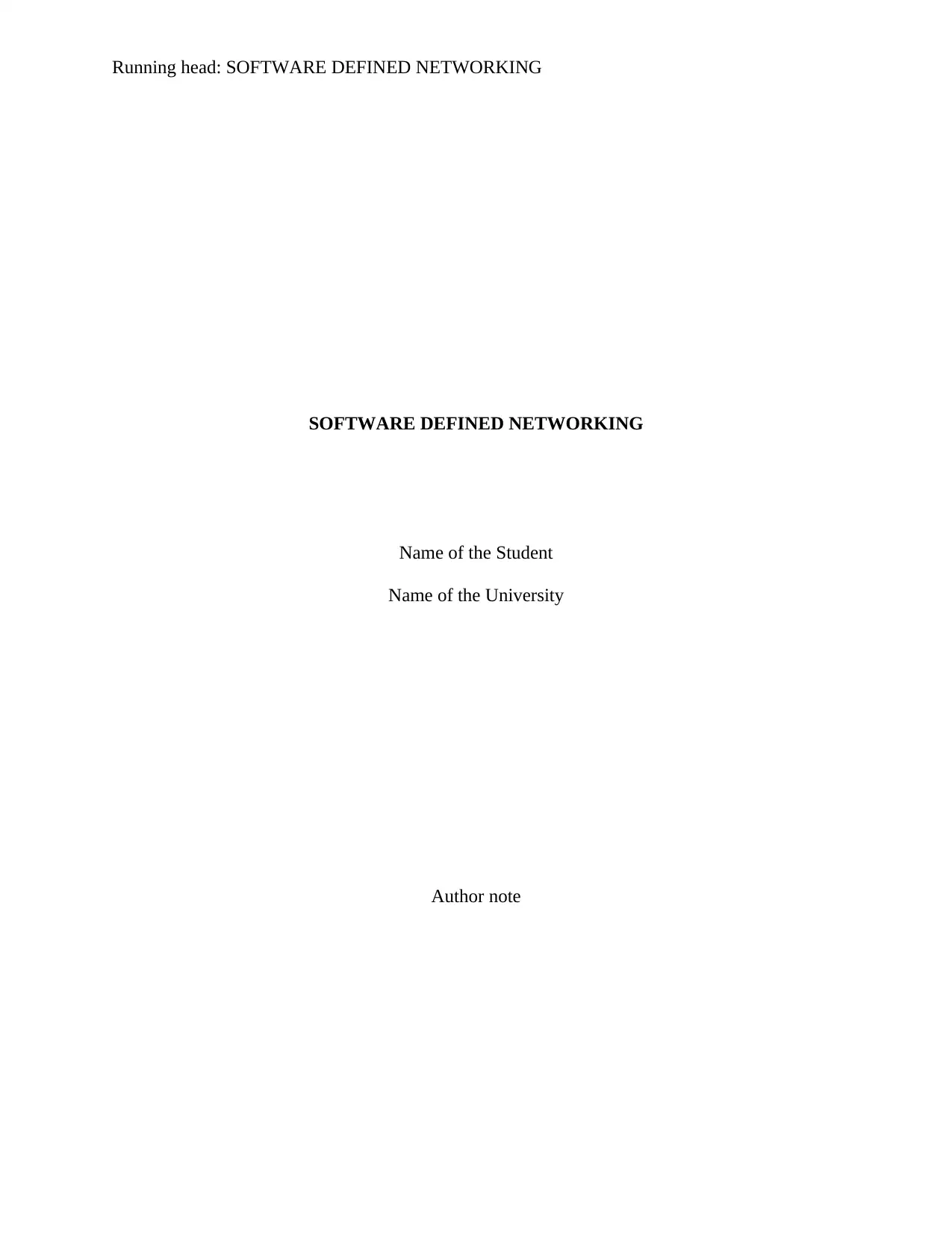
Running head: SOFTWARE DEFINED NETWORKING
SOFTWARE DEFINED NETWORKING
Name of the Student
Name of the University
Author note
SOFTWARE DEFINED NETWORKING
Name of the Student
Name of the University
Author note
Secure Best Marks with AI Grader
Need help grading? Try our AI Grader for instant feedback on your assignments.
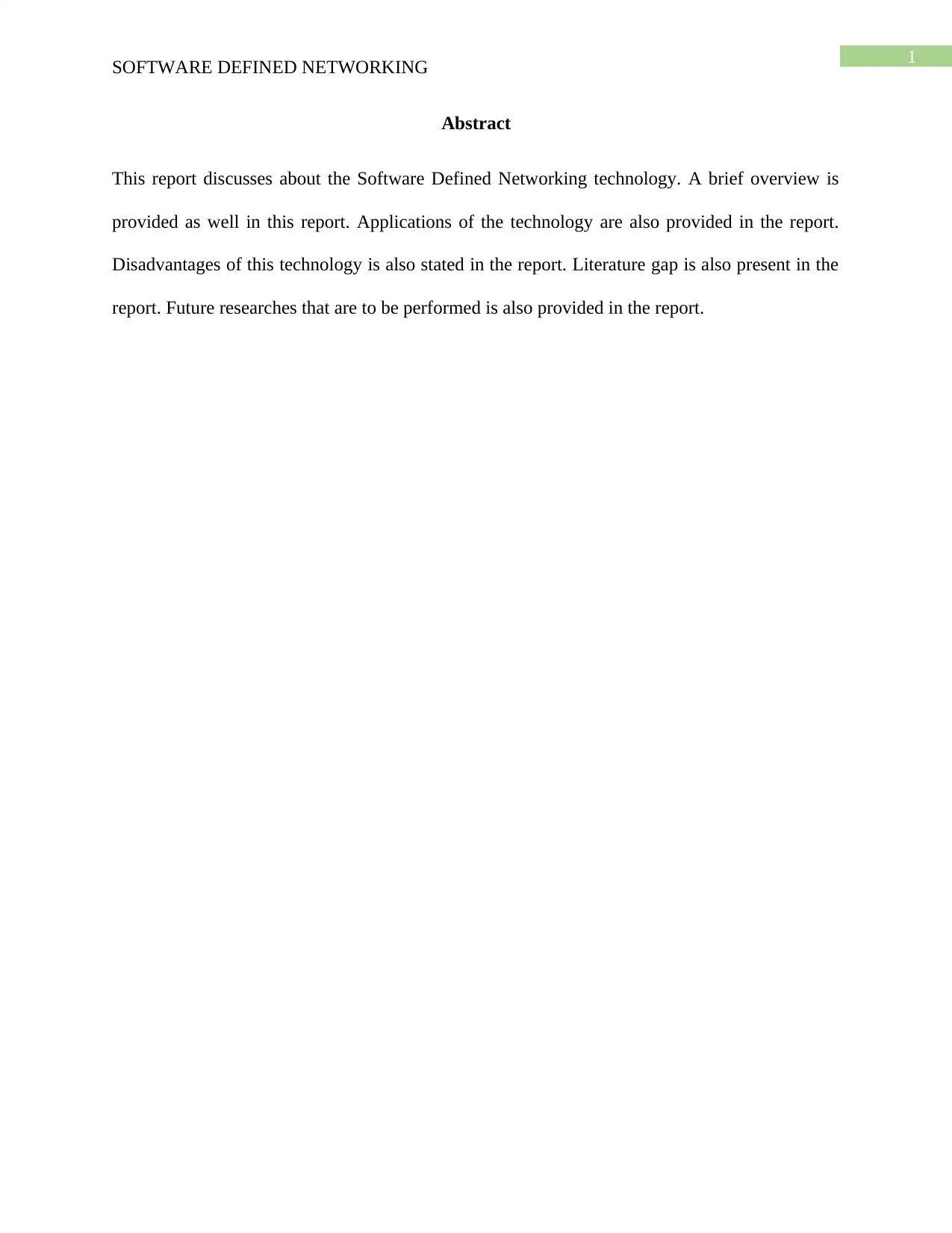
1
SOFTWARE DEFINED NETWORKING
Abstract
This report discusses about the Software Defined Networking technology. A brief overview is
provided as well in this report. Applications of the technology are also provided in the report.
Disadvantages of this technology is also stated in the report. Literature gap is also present in the
report. Future researches that are to be performed is also provided in the report.
SOFTWARE DEFINED NETWORKING
Abstract
This report discusses about the Software Defined Networking technology. A brief overview is
provided as well in this report. Applications of the technology are also provided in the report.
Disadvantages of this technology is also stated in the report. Literature gap is also present in the
report. Future researches that are to be performed is also provided in the report.
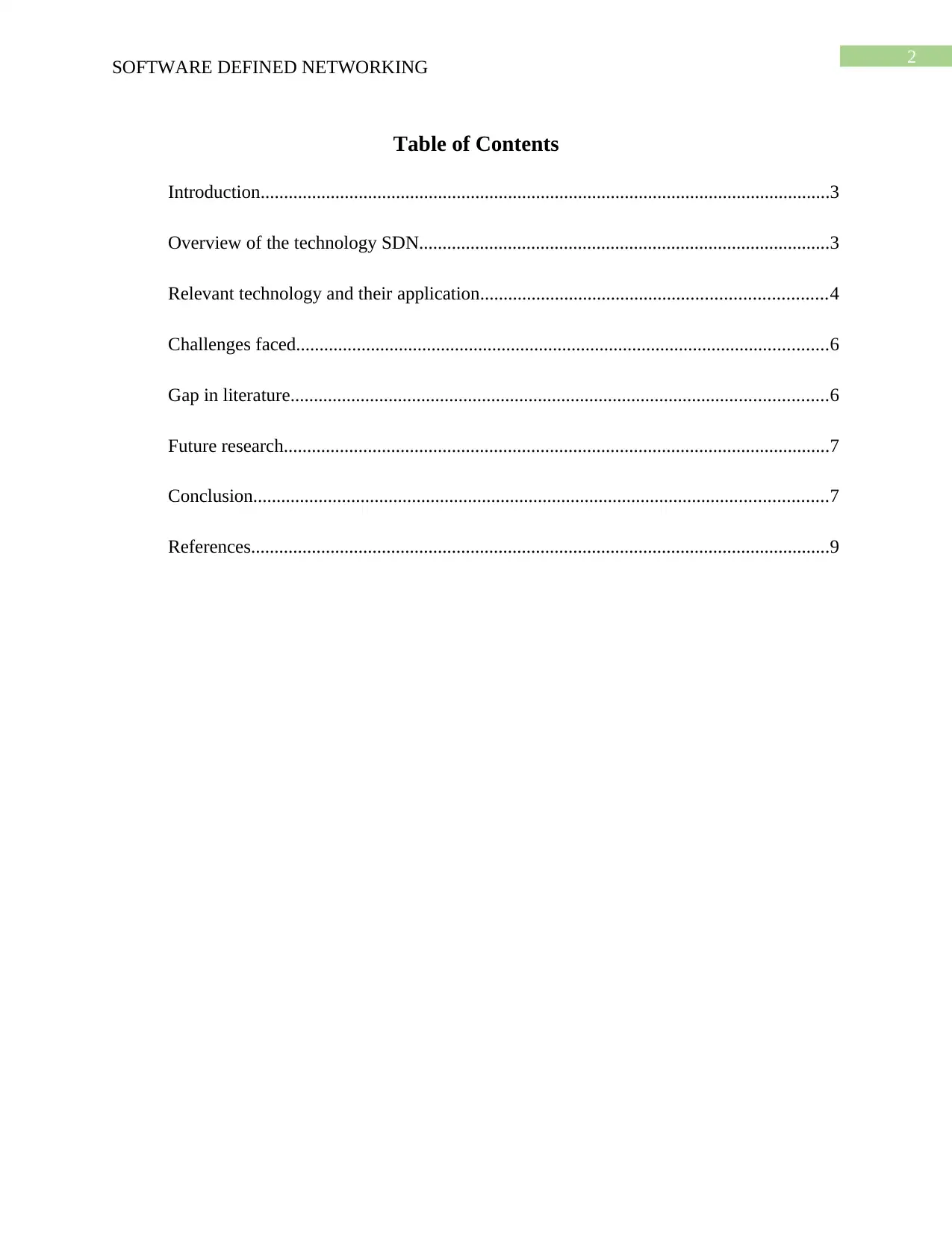
2
SOFTWARE DEFINED NETWORKING
Table of Contents
Introduction..........................................................................................................................3
Overview of the technology SDN........................................................................................3
Relevant technology and their application..........................................................................4
Challenges faced..................................................................................................................6
Gap in literature...................................................................................................................6
Future research.....................................................................................................................7
Conclusion...........................................................................................................................7
References............................................................................................................................9
SOFTWARE DEFINED NETWORKING
Table of Contents
Introduction..........................................................................................................................3
Overview of the technology SDN........................................................................................3
Relevant technology and their application..........................................................................4
Challenges faced..................................................................................................................6
Gap in literature...................................................................................................................6
Future research.....................................................................................................................7
Conclusion...........................................................................................................................7
References............................................................................................................................9
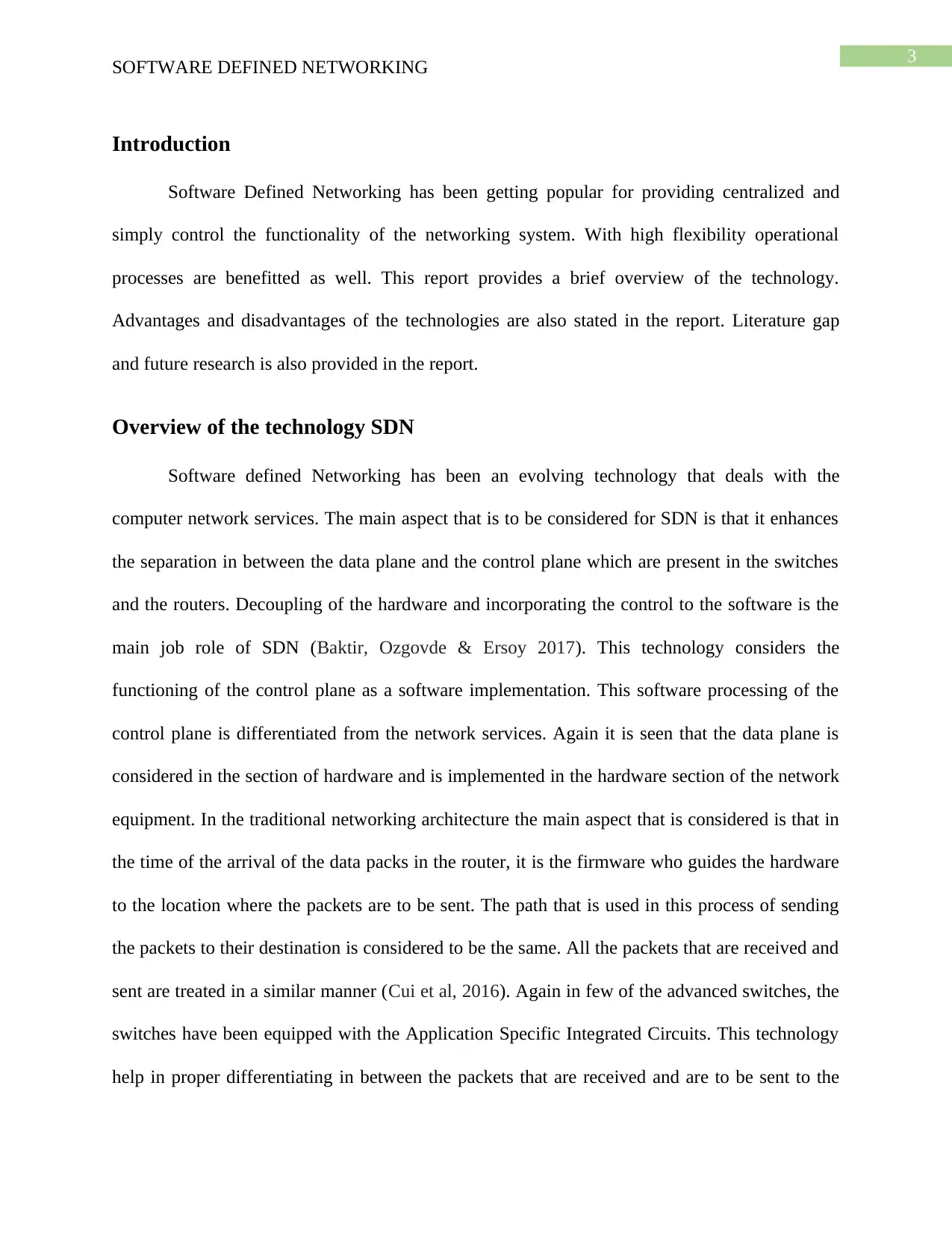
3
SOFTWARE DEFINED NETWORKING
Introduction
Software Defined Networking has been getting popular for providing centralized and
simply control the functionality of the networking system. With high flexibility operational
processes are benefitted as well. This report provides a brief overview of the technology.
Advantages and disadvantages of the technologies are also stated in the report. Literature gap
and future research is also provided in the report.
Overview of the technology SDN
Software defined Networking has been an evolving technology that deals with the
computer network services. The main aspect that is to be considered for SDN is that it enhances
the separation in between the data plane and the control plane which are present in the switches
and the routers. Decoupling of the hardware and incorporating the control to the software is the
main job role of SDN (Baktir, Ozgovde & Ersoy 2017). This technology considers the
functioning of the control plane as a software implementation. This software processing of the
control plane is differentiated from the network services. Again it is seen that the data plane is
considered in the section of hardware and is implemented in the hardware section of the network
equipment. In the traditional networking architecture the main aspect that is considered is that in
the time of the arrival of the data packs in the router, it is the firmware who guides the hardware
to the location where the packets are to be sent. The path that is used in this process of sending
the packets to their destination is considered to be the same. All the packets that are received and
sent are treated in a similar manner (Cui et al, 2016). Again in few of the advanced switches, the
switches have been equipped with the Application Specific Integrated Circuits. This technology
help in proper differentiating in between the packets that are received and are to be sent to the
SOFTWARE DEFINED NETWORKING
Introduction
Software Defined Networking has been getting popular for providing centralized and
simply control the functionality of the networking system. With high flexibility operational
processes are benefitted as well. This report provides a brief overview of the technology.
Advantages and disadvantages of the technologies are also stated in the report. Literature gap
and future research is also provided in the report.
Overview of the technology SDN
Software defined Networking has been an evolving technology that deals with the
computer network services. The main aspect that is to be considered for SDN is that it enhances
the separation in between the data plane and the control plane which are present in the switches
and the routers. Decoupling of the hardware and incorporating the control to the software is the
main job role of SDN (Baktir, Ozgovde & Ersoy 2017). This technology considers the
functioning of the control plane as a software implementation. This software processing of the
control plane is differentiated from the network services. Again it is seen that the data plane is
considered in the section of hardware and is implemented in the hardware section of the network
equipment. In the traditional networking architecture the main aspect that is considered is that in
the time of the arrival of the data packs in the router, it is the firmware who guides the hardware
to the location where the packets are to be sent. The path that is used in this process of sending
the packets to their destination is considered to be the same. All the packets that are received and
sent are treated in a similar manner (Cui et al, 2016). Again in few of the advanced switches, the
switches have been equipped with the Application Specific Integrated Circuits. This technology
help in proper differentiating in between the packets that are received and are to be sent to the
Secure Best Marks with AI Grader
Need help grading? Try our AI Grader for instant feedback on your assignments.
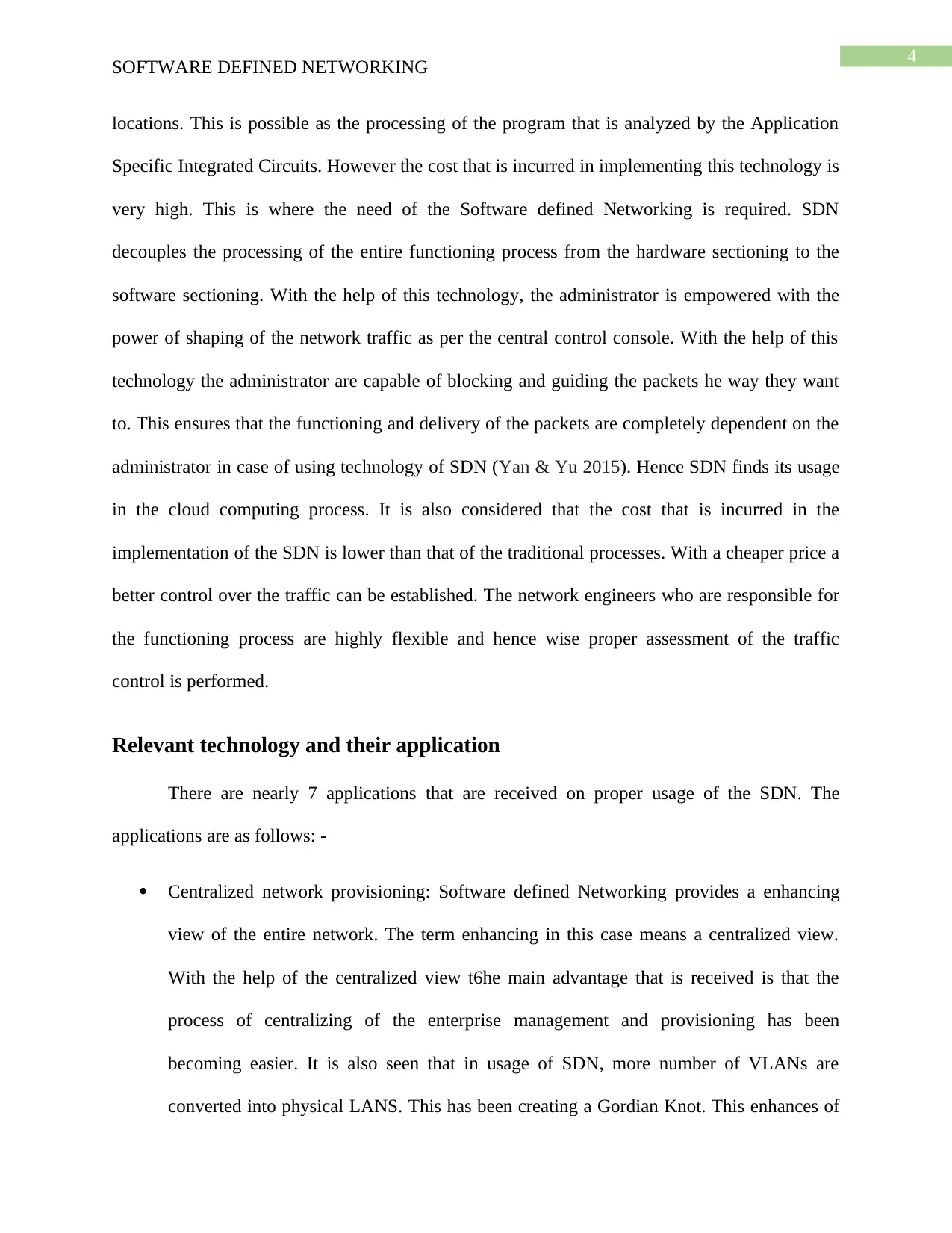
4
SOFTWARE DEFINED NETWORKING
locations. This is possible as the processing of the program that is analyzed by the Application
Specific Integrated Circuits. However the cost that is incurred in implementing this technology is
very high. This is where the need of the Software defined Networking is required. SDN
decouples the processing of the entire functioning process from the hardware sectioning to the
software sectioning. With the help of this technology, the administrator is empowered with the
power of shaping of the network traffic as per the central control console. With the help of this
technology the administrator are capable of blocking and guiding the packets he way they want
to. This ensures that the functioning and delivery of the packets are completely dependent on the
administrator in case of using technology of SDN (Yan & Yu 2015). Hence SDN finds its usage
in the cloud computing process. It is also considered that the cost that is incurred in the
implementation of the SDN is lower than that of the traditional processes. With a cheaper price a
better control over the traffic can be established. The network engineers who are responsible for
the functioning process are highly flexible and hence wise proper assessment of the traffic
control is performed.
Relevant technology and their application
There are nearly 7 applications that are received on proper usage of the SDN. The
applications are as follows: -
Centralized network provisioning: Software defined Networking provides a enhancing
view of the entire network. The term enhancing in this case means a centralized view.
With the help of the centralized view t6he main advantage that is received is that the
process of centralizing of the enterprise management and provisioning has been
becoming easier. It is also seen that in usage of SDN, more number of VLANs are
converted into physical LANS. This has been creating a Gordian Knot. This enhances of
SOFTWARE DEFINED NETWORKING
locations. This is possible as the processing of the program that is analyzed by the Application
Specific Integrated Circuits. However the cost that is incurred in implementing this technology is
very high. This is where the need of the Software defined Networking is required. SDN
decouples the processing of the entire functioning process from the hardware sectioning to the
software sectioning. With the help of this technology, the administrator is empowered with the
power of shaping of the network traffic as per the central control console. With the help of this
technology the administrator are capable of blocking and guiding the packets he way they want
to. This ensures that the functioning and delivery of the packets are completely dependent on the
administrator in case of using technology of SDN (Yan & Yu 2015). Hence SDN finds its usage
in the cloud computing process. It is also considered that the cost that is incurred in the
implementation of the SDN is lower than that of the traditional processes. With a cheaper price a
better control over the traffic can be established. The network engineers who are responsible for
the functioning process are highly flexible and hence wise proper assessment of the traffic
control is performed.
Relevant technology and their application
There are nearly 7 applications that are received on proper usage of the SDN. The
applications are as follows: -
Centralized network provisioning: Software defined Networking provides a enhancing
view of the entire network. The term enhancing in this case means a centralized view.
With the help of the centralized view t6he main advantage that is received is that the
process of centralizing of the enterprise management and provisioning has been
becoming easier. It is also seen that in usage of SDN, more number of VLANs are
converted into physical LANS. This has been creating a Gordian Knot. This enhances of
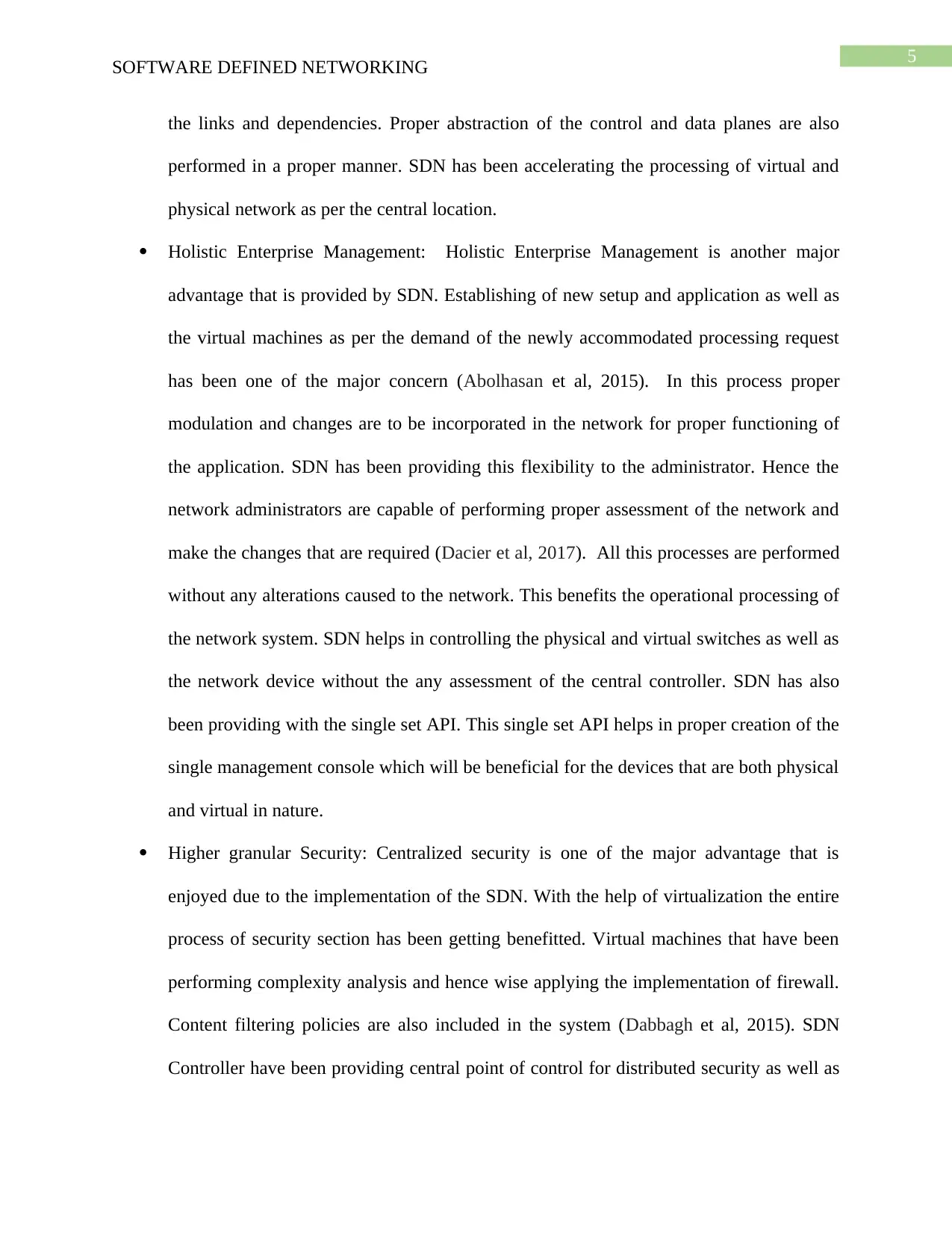
5
SOFTWARE DEFINED NETWORKING
the links and dependencies. Proper abstraction of the control and data planes are also
performed in a proper manner. SDN has been accelerating the processing of virtual and
physical network as per the central location.
Holistic Enterprise Management: Holistic Enterprise Management is another major
advantage that is provided by SDN. Establishing of new setup and application as well as
the virtual machines as per the demand of the newly accommodated processing request
has been one of the major concern (Abolhasan et al, 2015). In this process proper
modulation and changes are to be incorporated in the network for proper functioning of
the application. SDN has been providing this flexibility to the administrator. Hence the
network administrators are capable of performing proper assessment of the network and
make the changes that are required (Dacier et al, 2017). All this processes are performed
without any alterations caused to the network. This benefits the operational processing of
the network system. SDN helps in controlling the physical and virtual switches as well as
the network device without the any assessment of the central controller. SDN has also
been providing with the single set API. This single set API helps in proper creation of the
single management console which will be beneficial for the devices that are both physical
and virtual in nature.
Higher granular Security: Centralized security is one of the major advantage that is
enjoyed due to the implementation of the SDN. With the help of virtualization the entire
process of security section has been getting benefitted. Virtual machines that have been
performing complexity analysis and hence wise applying the implementation of firewall.
Content filtering policies are also included in the system (Dabbagh et al, 2015). SDN
Controller have been providing central point of control for distributed security as well as
SOFTWARE DEFINED NETWORKING
the links and dependencies. Proper abstraction of the control and data planes are also
performed in a proper manner. SDN has been accelerating the processing of virtual and
physical network as per the central location.
Holistic Enterprise Management: Holistic Enterprise Management is another major
advantage that is provided by SDN. Establishing of new setup and application as well as
the virtual machines as per the demand of the newly accommodated processing request
has been one of the major concern (Abolhasan et al, 2015). In this process proper
modulation and changes are to be incorporated in the network for proper functioning of
the application. SDN has been providing this flexibility to the administrator. Hence the
network administrators are capable of performing proper assessment of the network and
make the changes that are required (Dacier et al, 2017). All this processes are performed
without any alterations caused to the network. This benefits the operational processing of
the network system. SDN helps in controlling the physical and virtual switches as well as
the network device without the any assessment of the central controller. SDN has also
been providing with the single set API. This single set API helps in proper creation of the
single management console which will be beneficial for the devices that are both physical
and virtual in nature.
Higher granular Security: Centralized security is one of the major advantage that is
enjoyed due to the implementation of the SDN. With the help of virtualization the entire
process of security section has been getting benefitted. Virtual machines that have been
performing complexity analysis and hence wise applying the implementation of firewall.
Content filtering policies are also included in the system (Dabbagh et al, 2015). SDN
Controller have been providing central point of control for distributed security as well as
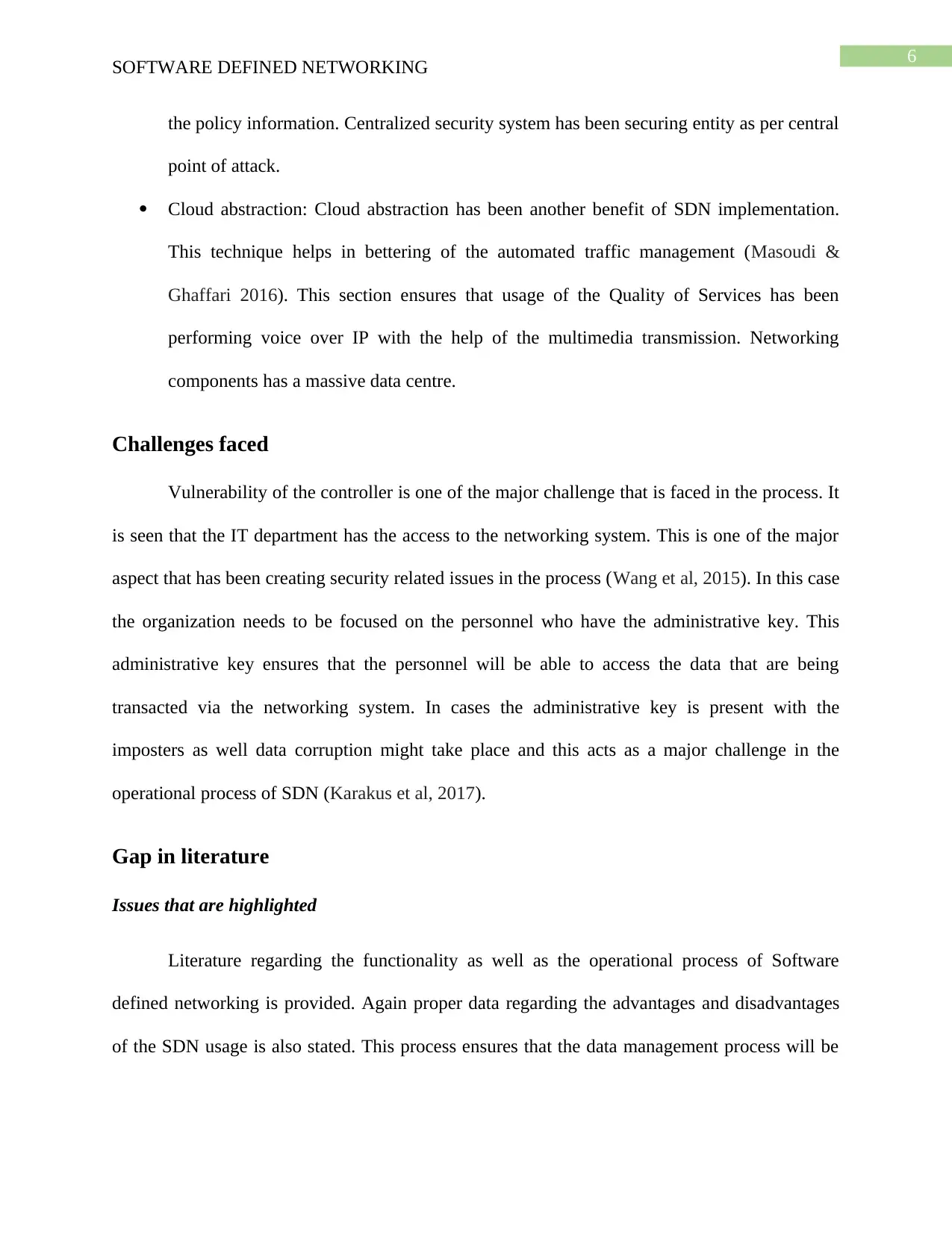
6
SOFTWARE DEFINED NETWORKING
the policy information. Centralized security system has been securing entity as per central
point of attack.
Cloud abstraction: Cloud abstraction has been another benefit of SDN implementation.
This technique helps in bettering of the automated traffic management (Masoudi &
Ghaffari 2016). This section ensures that usage of the Quality of Services has been
performing voice over IP with the help of the multimedia transmission. Networking
components has a massive data centre.
Challenges faced
Vulnerability of the controller is one of the major challenge that is faced in the process. It
is seen that the IT department has the access to the networking system. This is one of the major
aspect that has been creating security related issues in the process (Wang et al, 2015). In this case
the organization needs to be focused on the personnel who have the administrative key. This
administrative key ensures that the personnel will be able to access the data that are being
transacted via the networking system. In cases the administrative key is present with the
imposters as well data corruption might take place and this acts as a major challenge in the
operational process of SDN (Karakus et al, 2017).
Gap in literature
Issues that are highlighted
Literature regarding the functionality as well as the operational process of Software
defined networking is provided. Again proper data regarding the advantages and disadvantages
of the SDN usage is also stated. This process ensures that the data management process will be
SOFTWARE DEFINED NETWORKING
the policy information. Centralized security system has been securing entity as per central
point of attack.
Cloud abstraction: Cloud abstraction has been another benefit of SDN implementation.
This technique helps in bettering of the automated traffic management (Masoudi &
Ghaffari 2016). This section ensures that usage of the Quality of Services has been
performing voice over IP with the help of the multimedia transmission. Networking
components has a massive data centre.
Challenges faced
Vulnerability of the controller is one of the major challenge that is faced in the process. It
is seen that the IT department has the access to the networking system. This is one of the major
aspect that has been creating security related issues in the process (Wang et al, 2015). In this case
the organization needs to be focused on the personnel who have the administrative key. This
administrative key ensures that the personnel will be able to access the data that are being
transacted via the networking system. In cases the administrative key is present with the
imposters as well data corruption might take place and this acts as a major challenge in the
operational process of SDN (Karakus et al, 2017).
Gap in literature
Issues that are highlighted
Literature regarding the functionality as well as the operational process of Software
defined networking is provided. Again proper data regarding the advantages and disadvantages
of the SDN usage is also stated. This process ensures that the data management process will be
Paraphrase This Document
Need a fresh take? Get an instant paraphrase of this document with our AI Paraphraser
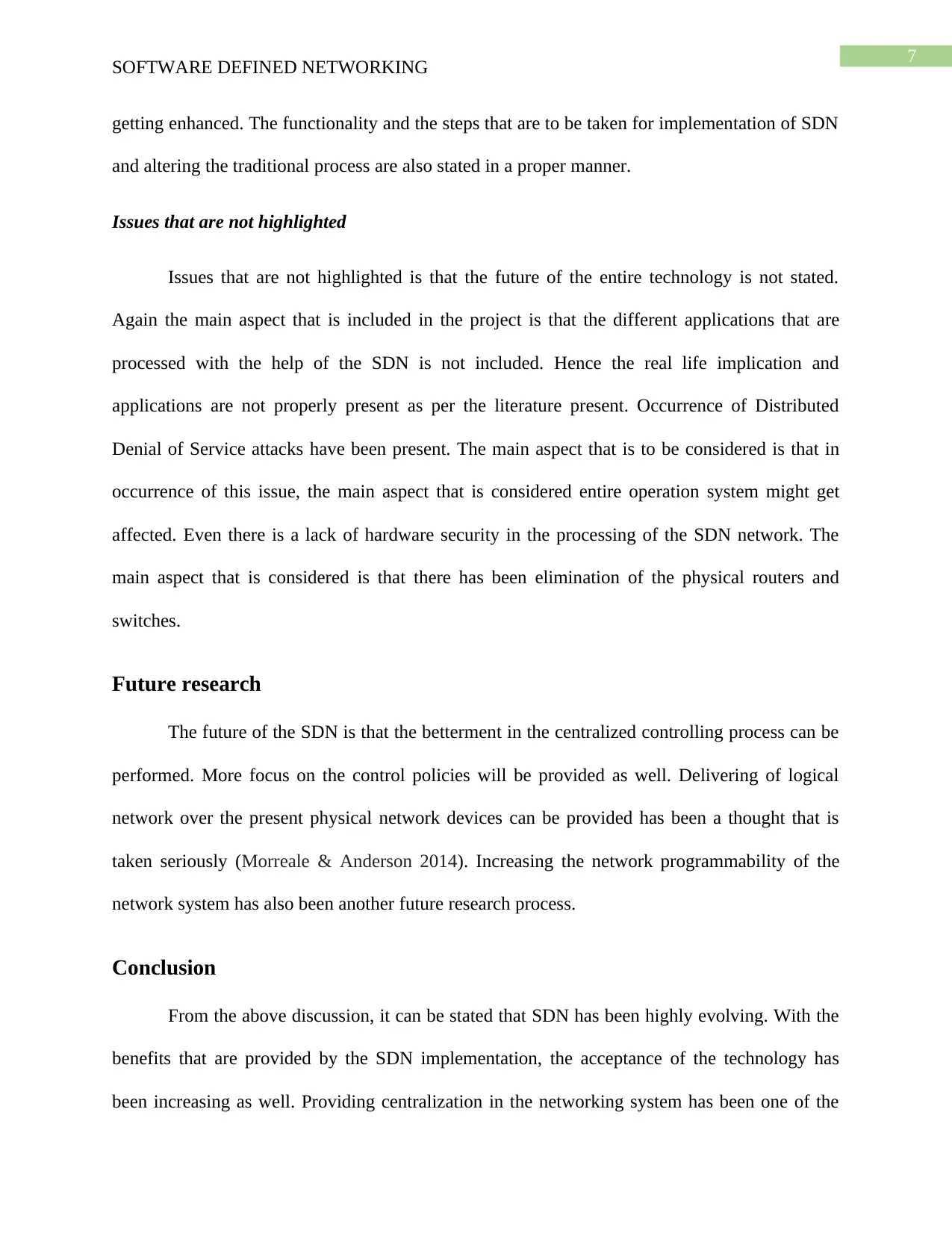
7
SOFTWARE DEFINED NETWORKING
getting enhanced. The functionality and the steps that are to be taken for implementation of SDN
and altering the traditional process are also stated in a proper manner.
Issues that are not highlighted
Issues that are not highlighted is that the future of the entire technology is not stated.
Again the main aspect that is included in the project is that the different applications that are
processed with the help of the SDN is not included. Hence the real life implication and
applications are not properly present as per the literature present. Occurrence of Distributed
Denial of Service attacks have been present. The main aspect that is to be considered is that in
occurrence of this issue, the main aspect that is considered entire operation system might get
affected. Even there is a lack of hardware security in the processing of the SDN network. The
main aspect that is considered is that there has been elimination of the physical routers and
switches.
Future research
The future of the SDN is that the betterment in the centralized controlling process can be
performed. More focus on the control policies will be provided as well. Delivering of logical
network over the present physical network devices can be provided has been a thought that is
taken seriously (Morreale & Anderson 2014). Increasing the network programmability of the
network system has also been another future research process.
Conclusion
From the above discussion, it can be stated that SDN has been highly evolving. With the
benefits that are provided by the SDN implementation, the acceptance of the technology has
been increasing as well. Providing centralization in the networking system has been one of the
SOFTWARE DEFINED NETWORKING
getting enhanced. The functionality and the steps that are to be taken for implementation of SDN
and altering the traditional process are also stated in a proper manner.
Issues that are not highlighted
Issues that are not highlighted is that the future of the entire technology is not stated.
Again the main aspect that is included in the project is that the different applications that are
processed with the help of the SDN is not included. Hence the real life implication and
applications are not properly present as per the literature present. Occurrence of Distributed
Denial of Service attacks have been present. The main aspect that is to be considered is that in
occurrence of this issue, the main aspect that is considered entire operation system might get
affected. Even there is a lack of hardware security in the processing of the SDN network. The
main aspect that is considered is that there has been elimination of the physical routers and
switches.
Future research
The future of the SDN is that the betterment in the centralized controlling process can be
performed. More focus on the control policies will be provided as well. Delivering of logical
network over the present physical network devices can be provided has been a thought that is
taken seriously (Morreale & Anderson 2014). Increasing the network programmability of the
network system has also been another future research process.
Conclusion
From the above discussion, it can be stated that SDN has been highly evolving. With the
benefits that are provided by the SDN implementation, the acceptance of the technology has
been increasing as well. Providing centralization in the networking system has been one of the
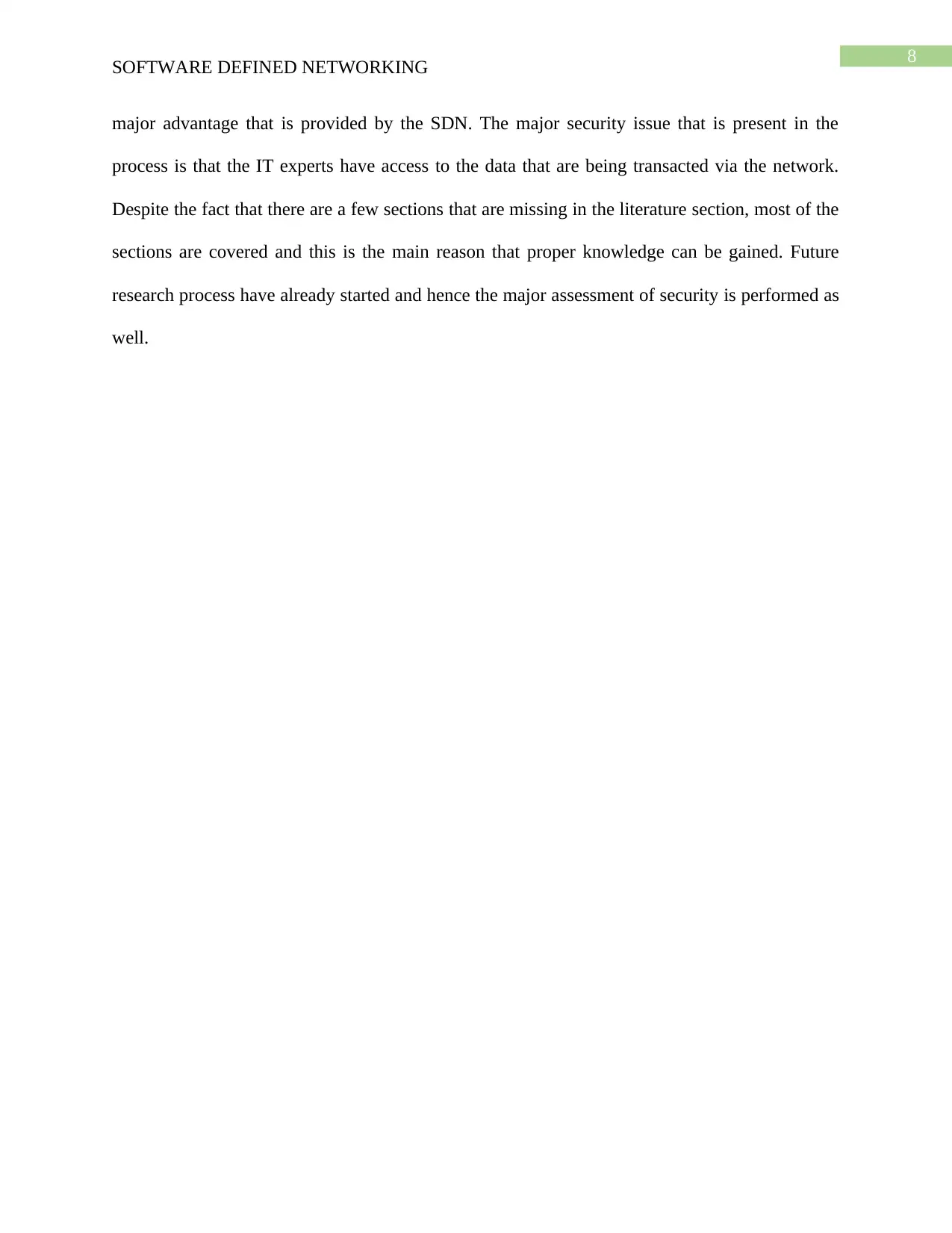
8
SOFTWARE DEFINED NETWORKING
major advantage that is provided by the SDN. The major security issue that is present in the
process is that the IT experts have access to the data that are being transacted via the network.
Despite the fact that there are a few sections that are missing in the literature section, most of the
sections are covered and this is the main reason that proper knowledge can be gained. Future
research process have already started and hence the major assessment of security is performed as
well.
SOFTWARE DEFINED NETWORKING
major advantage that is provided by the SDN. The major security issue that is present in the
process is that the IT experts have access to the data that are being transacted via the network.
Despite the fact that there are a few sections that are missing in the literature section, most of the
sections are covered and this is the main reason that proper knowledge can be gained. Future
research process have already started and hence the major assessment of security is performed as
well.
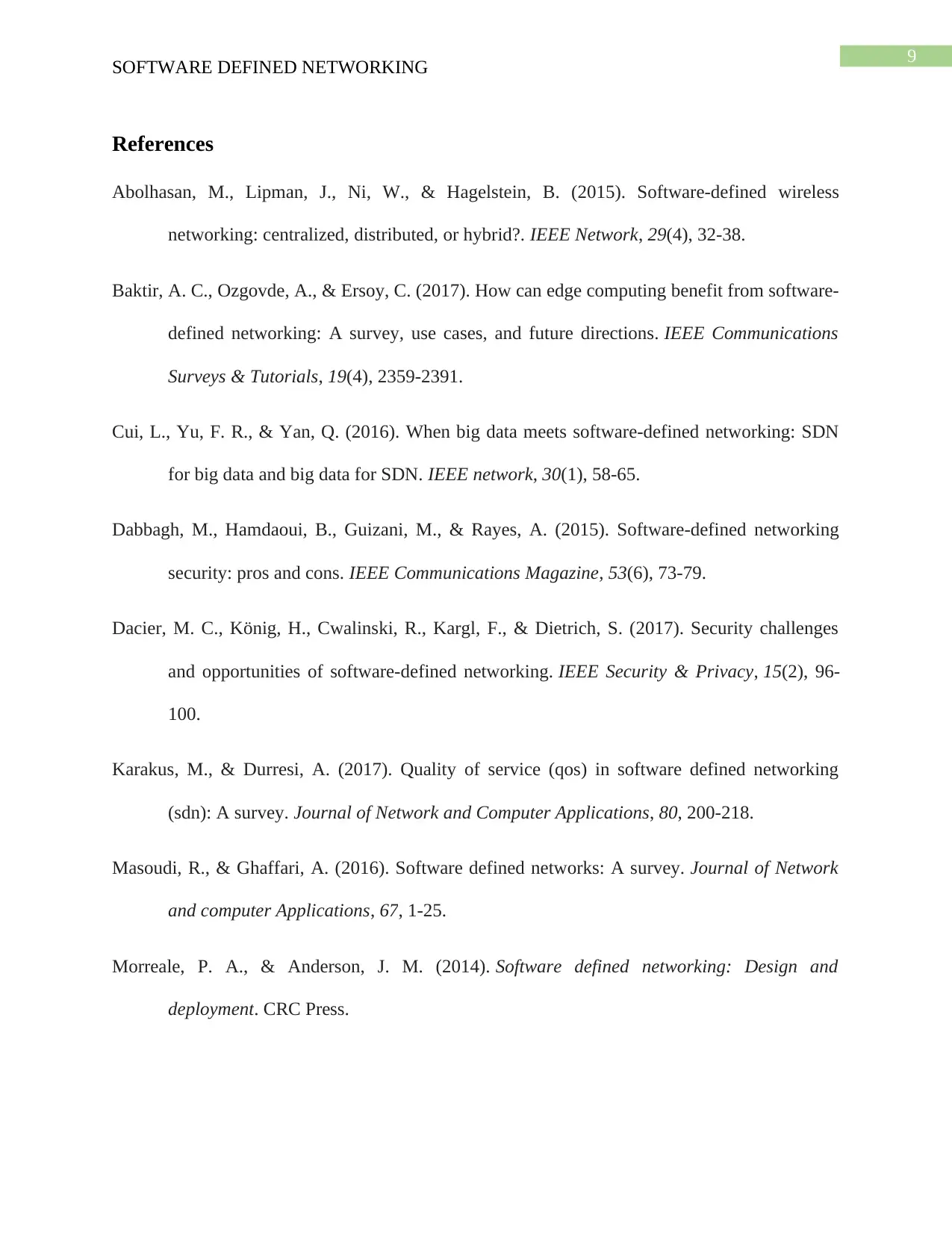
9
SOFTWARE DEFINED NETWORKING
References
Abolhasan, M., Lipman, J., Ni, W., & Hagelstein, B. (2015). Software-defined wireless
networking: centralized, distributed, or hybrid?. IEEE Network, 29(4), 32-38.
Baktir, A. C., Ozgovde, A., & Ersoy, C. (2017). How can edge computing benefit from software-
defined networking: A survey, use cases, and future directions. IEEE Communications
Surveys & Tutorials, 19(4), 2359-2391.
Cui, L., Yu, F. R., & Yan, Q. (2016). When big data meets software-defined networking: SDN
for big data and big data for SDN. IEEE network, 30(1), 58-65.
Dabbagh, M., Hamdaoui, B., Guizani, M., & Rayes, A. (2015). Software-defined networking
security: pros and cons. IEEE Communications Magazine, 53(6), 73-79.
Dacier, M. C., König, H., Cwalinski, R., Kargl, F., & Dietrich, S. (2017). Security challenges
and opportunities of software-defined networking. IEEE Security & Privacy, 15(2), 96-
100.
Karakus, M., & Durresi, A. (2017). Quality of service (qos) in software defined networking
(sdn): A survey. Journal of Network and Computer Applications, 80, 200-218.
Masoudi, R., & Ghaffari, A. (2016). Software defined networks: A survey. Journal of Network
and computer Applications, 67, 1-25.
Morreale, P. A., & Anderson, J. M. (2014). Software defined networking: Design and
deployment. CRC Press.
SOFTWARE DEFINED NETWORKING
References
Abolhasan, M., Lipman, J., Ni, W., & Hagelstein, B. (2015). Software-defined wireless
networking: centralized, distributed, or hybrid?. IEEE Network, 29(4), 32-38.
Baktir, A. C., Ozgovde, A., & Ersoy, C. (2017). How can edge computing benefit from software-
defined networking: A survey, use cases, and future directions. IEEE Communications
Surveys & Tutorials, 19(4), 2359-2391.
Cui, L., Yu, F. R., & Yan, Q. (2016). When big data meets software-defined networking: SDN
for big data and big data for SDN. IEEE network, 30(1), 58-65.
Dabbagh, M., Hamdaoui, B., Guizani, M., & Rayes, A. (2015). Software-defined networking
security: pros and cons. IEEE Communications Magazine, 53(6), 73-79.
Dacier, M. C., König, H., Cwalinski, R., Kargl, F., & Dietrich, S. (2017). Security challenges
and opportunities of software-defined networking. IEEE Security & Privacy, 15(2), 96-
100.
Karakus, M., & Durresi, A. (2017). Quality of service (qos) in software defined networking
(sdn): A survey. Journal of Network and Computer Applications, 80, 200-218.
Masoudi, R., & Ghaffari, A. (2016). Software defined networks: A survey. Journal of Network
and computer Applications, 67, 1-25.
Morreale, P. A., & Anderson, J. M. (2014). Software defined networking: Design and
deployment. CRC Press.
Secure Best Marks with AI Grader
Need help grading? Try our AI Grader for instant feedback on your assignments.

10
SOFTWARE DEFINED NETWORKING
Wang, B., Zheng, Y., Lou, W., & Hou, Y. T. (2015). DDoS attack protection in the era of cloud
computing and software-defined networking. Computer Networks, 81, 308-319.
Yan, Q., & Yu, F. R. (2015). Distributed denial of service attacks in software-defined
networking with cloud computing. IEEE Communications Magazine, 53(4), 52-59.
SOFTWARE DEFINED NETWORKING
Wang, B., Zheng, Y., Lou, W., & Hou, Y. T. (2015). DDoS attack protection in the era of cloud
computing and software-defined networking. Computer Networks, 81, 308-319.
Yan, Q., & Yu, F. R. (2015). Distributed denial of service attacks in software-defined
networking with cloud computing. IEEE Communications Magazine, 53(4), 52-59.
1 out of 11
Related Documents
Your All-in-One AI-Powered Toolkit for Academic Success.
+13062052269
info@desklib.com
Available 24*7 on WhatsApp / Email
![[object Object]](/_next/static/media/star-bottom.7253800d.svg)
Unlock your academic potential
© 2024 | Zucol Services PVT LTD | All rights reserved.





